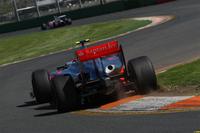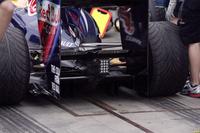F1 - The Diffuser Flappers
 |
Op-Ed - By Rick Carlton - PRRACEwire
Melbourne, March 27, 2009: In the midst of a host of off-season technical changes, and the additional application of “Max’s Folly”, also known as the KERS system (Kinetic Energy Recovery System), three of the teams in the F1 paddock still managed to figure out the first of this year’s “unfair advantages,, AKA “The Diffuser Flappers.’”
It seems that, while the FOTA boffins were busy trying to draw a new, cheaper 2009 “box” that would support Max Mosley’s cost-cutting, and at the same time “hybridize while dumbing down” the technology of F1 cars, the folks in Geneva settled on a group of conflicting rule changes that created significant reductions in rear-end down-force (smaller rear-wing), while at the same time increasing front-wing down-force (bigger front-wing). And, if that wasn’t enough to cause a designer to cry “Merde!”, Mosley’s “push to go” initiative also added 40 Kg worth of sprung weight to the car, a weight impact caused by the kinetic regeneration/storage unit used to convert braking friction to energy, i.e. KERS.
Practically speaking the conflicting technical jiggering was absolutely guaranteed to unbalance the essential aerodynamics of a race car - and if a car isn’t balanced it won’t turn, brake, or accelerate with certainty - clearly not a thing a driver looks forward to at nearly 200 mph. This being F1, however, three clever engineers at Panasonic, Brawn and Williams decided to do what F1 engineers do - figure out a way to work around the rules, overcome any embedded technical limitations, then sally forth to beat the other guys soundly.
Now, cut to the rear portion of a typical F1 racecar under-tray. The technical rules mandated that there be a strictly-sized void area under the rear of the car at the back of the under-tray. Although there was some small leeway in terms of creating a series of small baffles, or inverted strakes in the void area as an allowance for air flow smoothing, the void was not really intended to be used as an aerodynamic “working area”, so for most of the cars in the paddock, the area of interest could be rightly called a simple “hole” at the back of the car, rather than a particular area of “engineering focus.”.
See Figure 1. McLaren (photo provided by: Forrest Bond and RaceFax.com)
See Figure 2. Red Bull (photo provided by: Forrest Bond and RaceFax.com)
However, the three teams figured that the old military axiom held true, i.e. “That which is not specifically proscribed is therefore acceptable,” or more practically stated, “Better to ask for forgiveness than to ask for permission.” So, instead of accepting the non-interest in the back of the car, the teams got interested and built an additional structure in the middle of the void area, just under the rain-light. The structure created a venturi effect at the center line while “extending” the car’s longitudinal moment. And this allowed the structure to produce more than enough down-force to counter the smaller rear-wing, and recover the balance they had lost.
Figure 3. Panasonic Toyota (photo provided by: Forrest Bond and RaceFax.com)
Of course, when the teams got wind of the little “modification” and after seeing Panasonic, Brawn and Williams at the top of the charts in the first session, there was much whining and clutching of hands by the non-diffuser flappers. Nonetheless, after an on-track technical review, even King Max The First was impressed calling the aero innovation a “…clever application of the rules.” By today (Australian time), several of the other teams were trying the same tweak on their own cars, so we’ll see what happens in qualifying. But it’s nice to see that somebody in F1 is still interested in thinking through technical problems rather than simply accepting the conventional.





